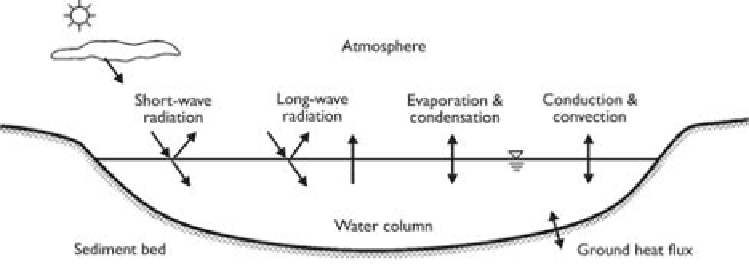Geoscience Reference
In-Depth Information
Figure 12.1
Heat budget in water column.
Short-wave radiation
Radiation emitted by the sun is termed short-wave or solar radiation. The net short-
wave radiation (W
m
−
2
) penetrating the water can be determined by (TVA —
Tennessee Valley Authority, 1972; Jacquet, 1983)
·
0.65
C
cloud
)(
J
Tsw
=
J
Tsw
,
clear
(
1
−
1
−
R
tsw
)(
1
−
f
shade
)
(12.27)
m
−
2
) that would reach the water sur-
face in a clear day after atmospheric attenuation,
C
cloud
is the fractional cloud cover
between 0 and 1,
R
tsw
is the dimensionless surface reflexivity, and
f
shade
is the shading
factor of riparian vegetation.
The short-wave radiation reaching the water surface on a clear day,
J
Tsw
,
clear
,is
related to the distance between the sun and earth, solar declination, and latitude of
the local meridian, and is affected by atmosphere scattering and absorption (TVA,
1972; Brown and Barwell, 1987; Deas and Lowney, 2000). Solar radiation may be
measured relatively inexpensively, and is reported by some weather stations. If the
measured data are available, the cloud cover term in Eq. (12.27) may be eliminated
(but not the reflectivity and shading factor).
The reflection coefficient
R
tsw
depends on cloud cover and altitude of the sun, and
the shading factor
f
shade
depends on vegetation height, bearing of the sun, etc. The
details may be found in Brown and Barwell (1987) and Deas and Lowney (2000).
where
J
Tsw
,
clear
is the short-wave radiation (W
·
Long-wave radiation
Radiation emitted by terrestrial objects and atmosphere is termed long-wave radiation.
The net long-wave radiation at the water surface is the result of two processes: the
downward radiation from the atmosphere and the upward radiation emitted by the
water surface. The long-wave radiation largely depends on air temperature, humidity,
and cloud cover. Hodges (1998) rewrote the formulas of long-wave heat flux proposed

